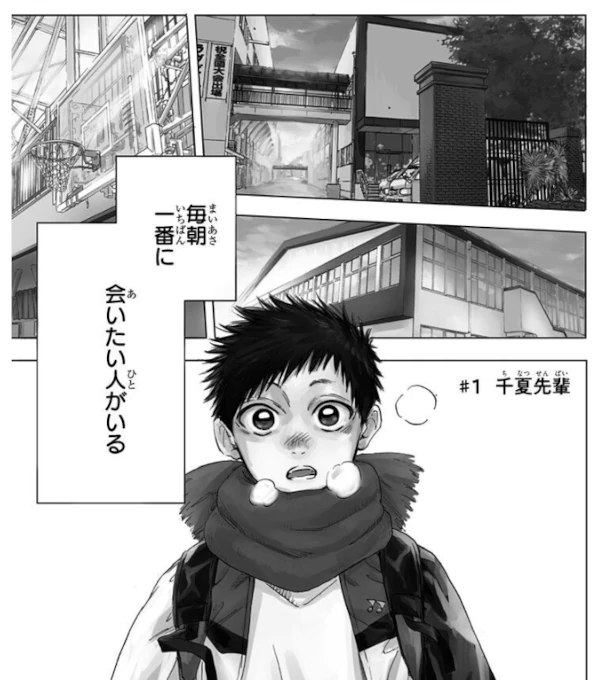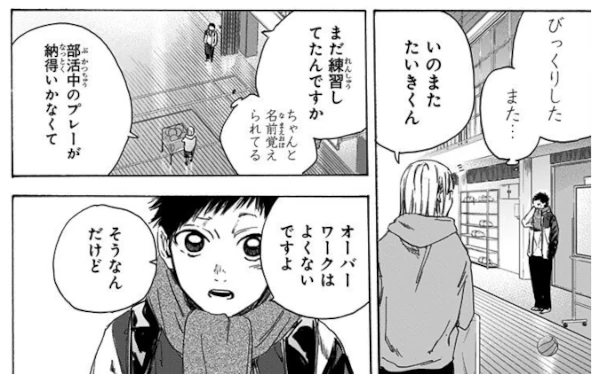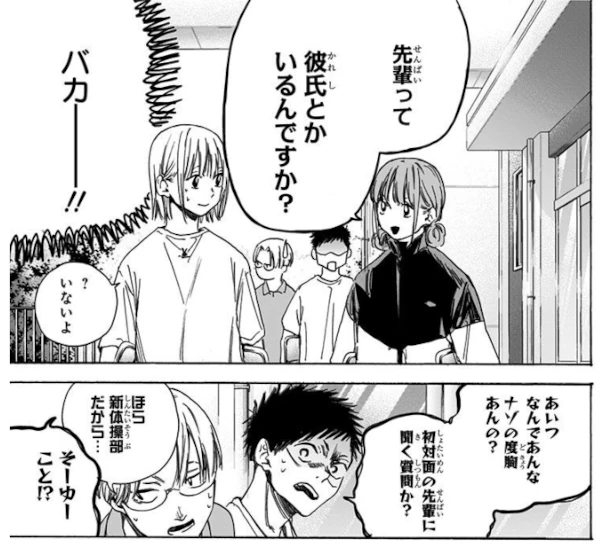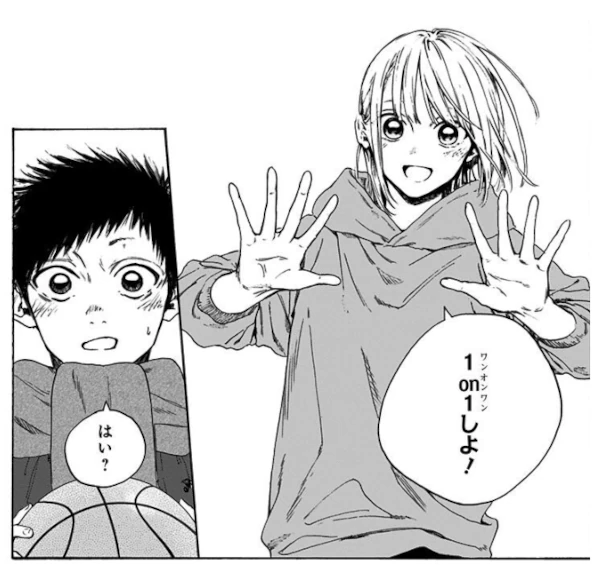This time, we’re introducing Ao no Hako(Blue Box) —a refreshing Shonen Jump romance that lets you experience realistic Japanese conversations while enjoying the bittersweet beauty of first love.
Work Information

Ao no Hako(アオのハコ)
Author: Miura Kouji
Publisher: SHUEISHA
Amount of text: moderate
Challenge level: ★★
Latest volume : Vol.22(Nov.2025 / Ongoing)
Story overview
Taiki Inomata, a member of the badminton team, has fallen for Chinatsu Kano, a senior from the girls’ basketball club. He’s captivated by her dedication during early-morning practice sessions—but one day, an unexpected twist changes everything. The road to love is long, but their hearts are close. A tender, bittersweet youth romance begins.
The Appeal of This Manga
Ao no Hako(アオのハコ, Blue Box) is a romance manga currently serialized in Weekly Shonen Jump (as of November 2025) and has also been adapted into an anime. Unlike the typical “romantic comedy” or harem-style love stories often seen in Jump, this series focuses quietly and sincerely on a one-on-one romance—will Taiki’s unrequited feelings ever reach Chinatsu?
It’s a refreshing take within the Shonen Jump tradition: realistic emotions, delicate pacing, and an almost shōjo manga-like sensitivity. Readers of all ages can rediscover the fluttering excitement of first love and the everyday struggles of adolescence.

Why this manga is suitable for learning Japanese
This manga is not only entertaining but also highly recommended for Japanese learners for several reasons.
Natural Use of Casual Keigo
Taiki’s crush, Chinatsu, is one year older and his senpai. As a result, he always speaks to her in polite Japanese (敬語). While their conversations use casual, high school–level speech, they still follow the fundamentals of polite communication—great for learners to observe how keigo works naturally among teens.

Switching Between Casual and Polite Speech
Taiki speaks casually (タメ口) with classmates and politely with upperclassmen. In Japanese, speech levels change depending on the relationship between speakers. This Manga offers many examples of these subtle shifts, making it a valuable reference for understanding how to navigate both formal and friendly conversations in real life.

Culture Spotlight
The Meaning of “Ao no Hako”: Why the School Gym Holds the Color of Youth体育館
In Ao no Hako (Blue Box), the title itself captures something deeply Japanese—the feeling of youth condensed into a single space: the school gym (体育館, taiikukan). At first glance, it’s just a sports facility. But in Japanese school life, the gym carries emotional weight far beyond its wooden floor and basketball hoops. It’s a container of youth, a place where effort, admiration, and quiet longing come together.

The Gym as the “Box” of Youth
Every Japanese school has a gym used for P.E. classes, club activities, and ceremonies. It’s a place where students practice, perform, compete, and even fall in love. From the morning light streaming through high windows to the sound of sneakers squeaking on the floor, the gym is filled with the energy of 青春 (seishun)—the Japanese concept of youth as a season of intensity and purity.
In stories like Ao no Hako, the gym becomes the “hako” (box) that contains those moments. It holds the struggles of athletes, the nervous glances between senpai and kōhai, and the bittersweet silence after a match. It’s a private world shared among students, yet public enough for emotions to overflow.
The “Ao” Aesthetic: From Color to Feeling
The word ao (青) literally means “blue,” but in Japanese, it carries emotional depth that goes beyond color. It can evoke freshness, sincerity, and a sense of beautiful impermanence—qualities often associated with adolescence.
The term “アオハル” (Aoharu) gained wide recognition in the 2010s through the manga Ao Haru Ride(アオハライド), which playfully reinterpreted the traditional word 青春 (seishun, “youth”). Its soft katakana form gave the idea of youth a fresh, emotional resonance, and readers embraced it as a poetic way to describe the shining yet fleeting days of adolescence.
By writing “アオ” in katakana, rather than the kanji “青,” creators give the word a softer, modern, and more emotional tone. It feels less like a literal color and more like a mood—cool, lyrical, and cinematic. In Ao no Hako, “アオ” represents that bittersweet emotional palette: the freshness of youth mixed with uncertainty and longing.
Why “Hako” (Box)?
The “box” in the title symbolizes containment—a physical space that holds feelings too big to express directly. The gym, with its echoes and boundaries, becomes a metaphorical box of emotions where students’ dreams and frustrations are stored. It’s both open and enclosed, public and private—just like the delicate stage of adolescence itself.
In this sense, Ao no Hako literally means “The Box of Youthful Blue”: a place where the color of youth gathers, waiting to be noticed.
What It Means for Learners
For learners of Japanese language and culture, understanding words like “アオ” and “ハコ” offers more than vocabulary—it opens a window into the emotional logic of Japanese storytelling. Japanese often uses imagery and sound to convey emotion indirectly; the use of katakana here is part of that artistry.
When you hear “アオハル” or see a scene set in a taiikukan, remember: it’s not just about school life. It’s about the fragile beauty of effort, connection, and change—the kind of emotion that defines Japanese notions of youth.
A Little Warning
Is it a bit too convenient?
Without giving away spoilers, let’s just say that several events unfold rather favorably for the protagonist. But it’s Shonen Jump, after all—so let’s enjoy the optimism and emotional honesty that make this story so endearing.

Work Information

Ao no Hako(アオのハコ)
Author: Miura Koji
Publisher: SHUEISHA
Amount of text: moderate
Challenge level: ★★
Latest volume : Vol.22(Nov.2025 / Ongoing)
Here’s a safe and convenient way to purchase Japanese manga.
This Blog’s ConceptIn this blog, we are introducing manga that are not only highly captivating but also ideal for Japanese language learners. Studying Japanese through manga is both fun and effective. Manga allows you to understand the subtleties of keigo (honorifics), teineigo (polite speech), and casual conversation in Japanese. We hope you find works that match your interests and use them to enhance your Japanese learning journey.